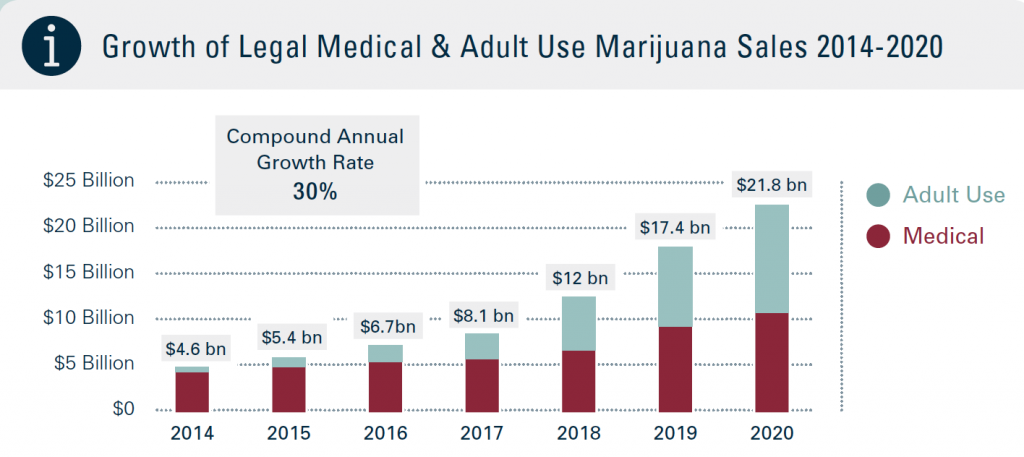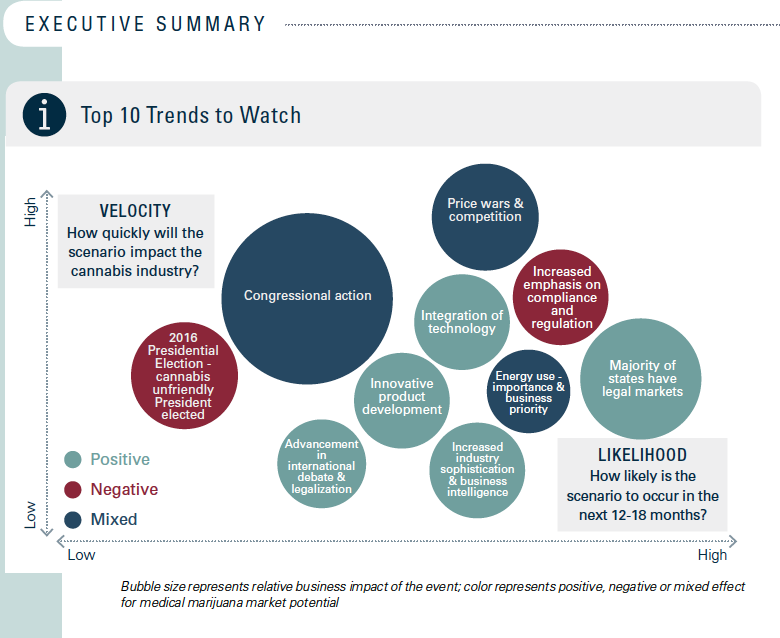
Economics
Massive Growth Forecast for America’s Cannabis Industry
If the steady drumbeat of legalization progress hadn’t already made it obvious, new market research produced by the nation’s foremost cannabis industry analysts predicts marijuana will be America’s unrivaled growth sector over the next several years.
“Thirty percent compound annual growth for five to six years?” rhetorically asked ArcView Group chief executive officer Troy Dayton, pausing for effect.
“You cannot find another industry that grows 30 percent for six years straight,” he said, with emphasis. “It’s incredible.”

Dayton, whose Bay Area-based group produced a legal cannabis market sales forecast of $21.8 billion in 2020, up from $5.4 billion in 2015, told Cannabis Now in an interview that his team’s new partnership with New Frontier, which co-produced and co-published the report, allowed it a fuller and more complete assessment of the emerging market.
What’s different? “We’re measuring different things than we used to measure,” he said. In years past, ArcView numbers had been limited to dispensary sales, but the partnership with New Frontier provided a much more robust measuring ability for related industry markets such as caregivers and dispensary services. “It’s a completely different methodology,” Dayton said.
He also cited better government data and the use of statistical analysis modeling to continually improve the forecast model.
Dayton underscored the importance of legalized adult use, highlighting the whopping 184 percent increase in that market from 2014 to 2015, up from $351 million to $998 million.
He said that while “Washington figured out how to make the market work,” clearly referring to the state and not the nation’s federal capital, it’s California’s adult use initiative this fall that currently stands as the most likely final tipping point. Although the Golden State is not the only one likely to add its name to the expanding roster of states where pot is legal for adults, it would be the world’s eighth largest economy if it were its own nation.
Once California legalizes adult cannabis use, it’s game over for current hurdles like banking and Internal Revenue Service 280E reform. The pressure for Congress to act on those issues, assuming it hasn’t already, will be immense. “It’s going to create so much economic activity that it will be impossible to ignore the situation,” Dayton said of California’s likely imminent legal adult market. “To have that be running on cash is crazy.”
With an adult use market too large to ignore, federal hands will be forced into reform. Soon, the report predicts, the adult use market will be over half of the entire industry, comprising $11.67 billion alone, compared with $10.15 billion in the medical market.
John Kagia, who co-edited the report for New Frontier in partnership with ArcView, talked to us about the likelihood of significant factors that will impact the industry. Citing a “very, very healthy appetite” for cannabis reflected in the report’s bullish forecast, he noted that progress is aided by an already gathering volume of state-level data disproving dire warnings over legalization’s purported ills.
“Many of the great fears that have been put forth by prohibitionists have just not materialized,” Kagia pointed out. For example, the “disconnect” between prohibitionist doom-and-gloom predictions and subsequently observed results, Kagia said, has itself been instructive to cautious skeptics such as Colorado Governor John Hickenlooper. Hickenlooper, who has been rumored as one potential Democratic vice-presidential pick, has become increasingly aware “what a legal, regulated marketplace can do.

A useful chart in the report’s executive summary shows what the data suggests are, relative to each other, the ten most significant factors affecting the market. Size of the bubble indicates how big the impact will be should the event occur. Going left to right is to gather increasing likelihood of the event, and going bottom to top on the chart is an increase in speed with which that event would affect the industry as a whole. By this measure, the report concludes Congressional action would have the biggest global impact among all the factors, price wars and competition will most rapidly affect revenues, and reaching a majority of states with at least legal medical marijuana is the most likely result by mid-2017.
While still important, factors like how quickly countries like Canada legalize aren’t as significant to the growth of the United States market as U.S. technological integration is, according to the authors.
Although the report’s publication came shortly before last weekend’s death of Justice Antonin Scalia, Kagia said a high court vacancy in an election year could put more Congressional seats in play than otherwise expected, which in turn could catalyze speedier Congressional action before next summer. Democrats would need to gain four Senate seats (and keep the presidency) to take the Judiciary Committee back from Iowa’s Chuck Grassley, who so far has not allowed the bipartisan CARERS Act a hearing. Grassley himself is up for a seventh term.
Ultimately, the market is exploding because it’s what Americans both want and have been voting for at the ballot box. Besides California, adult use is expected to reach the ballot in Arizona, Nevada, Maine and Massachusetts this year. Vermont and Rhode Island may legalize via legislature, much like Pennsylvania may do for medical cannabis. Ballot measures for medical marijuana in the fall are expected in Ohio, Missouri and Florida.
What do you think? Is the forecast too high, too low, or just right?
























